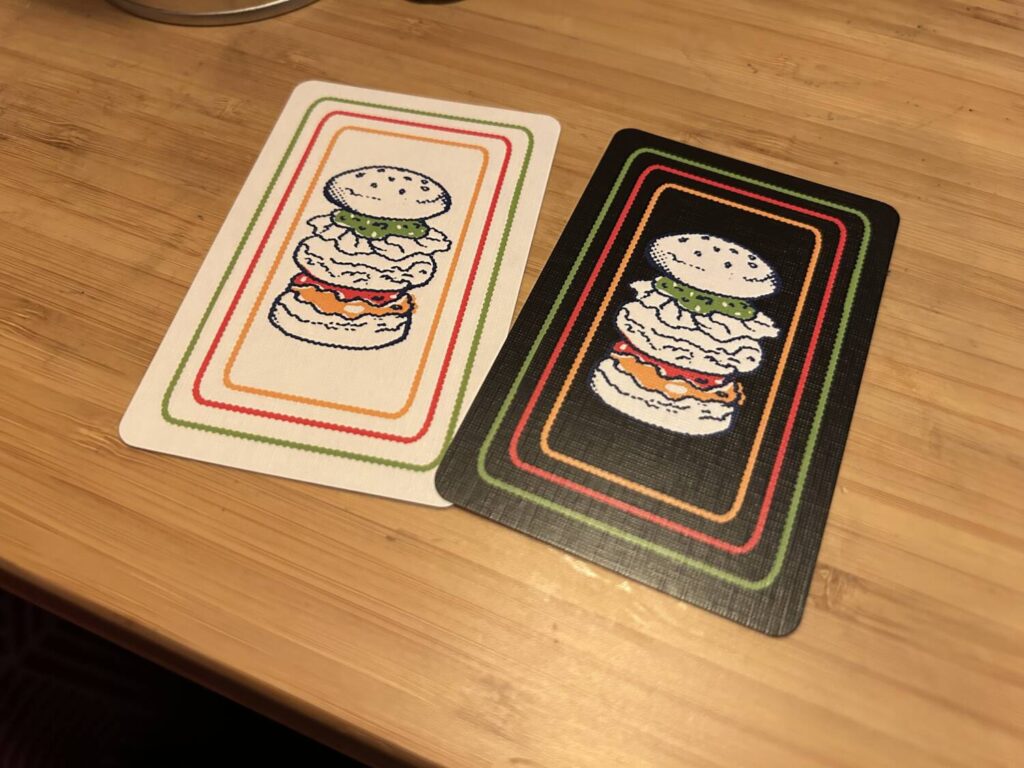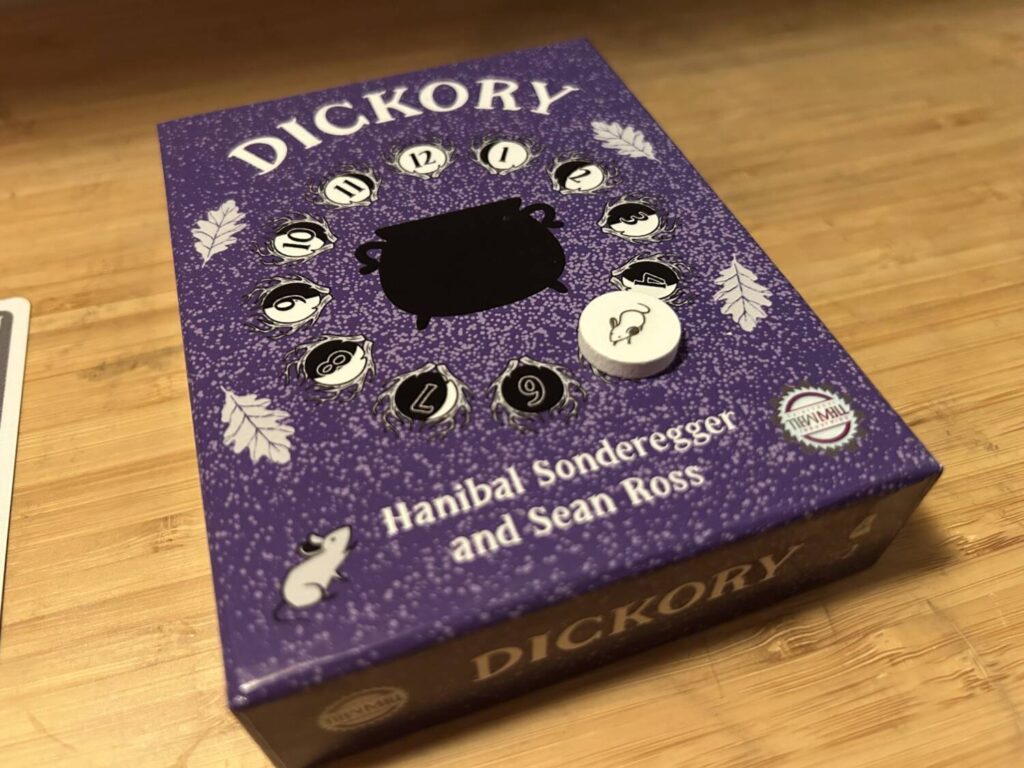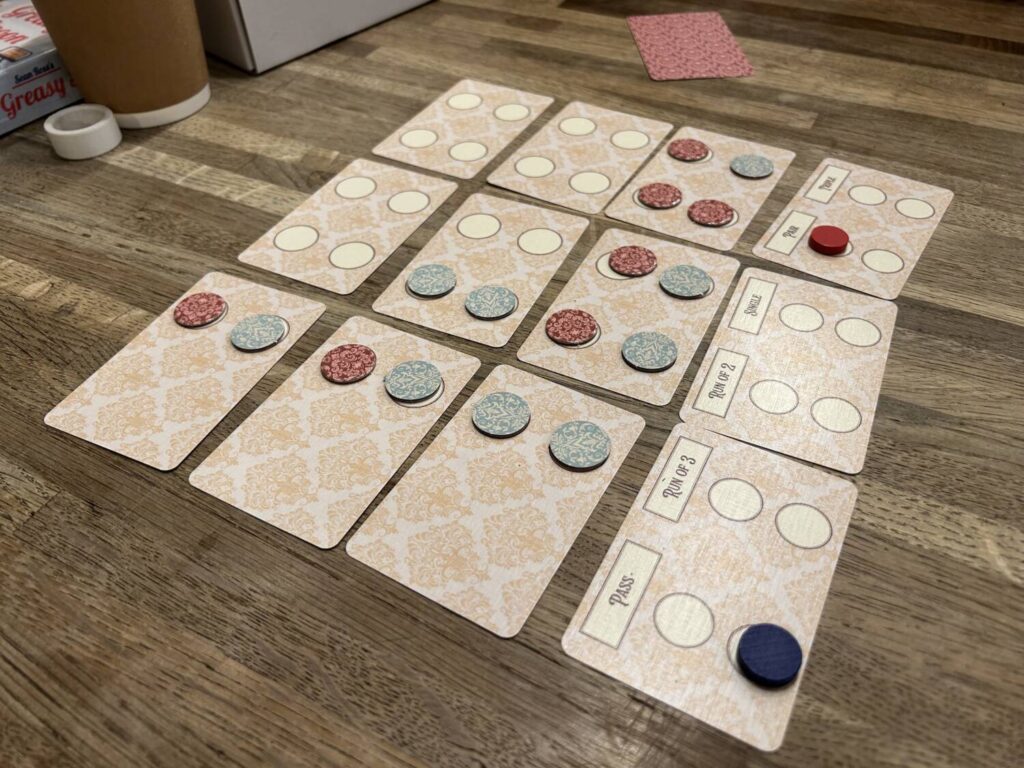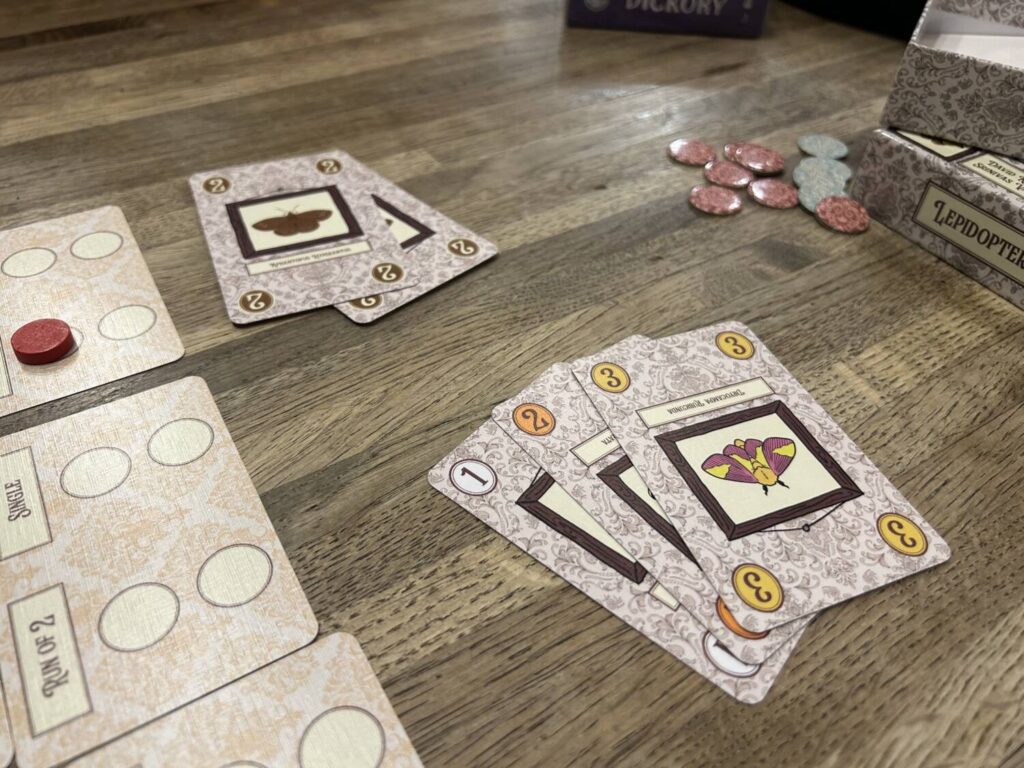Shedding games for two players are a difficult breed. I’ve written about this before, in my review of Thomas Lehmann’s admirable-but-middling Chu Han. There’s something about shedding—a family of traditional card games about playing cards in ever-escalating sets—that refuses to shine in the two-player format.
My diagnosis is that fewer players means less tension. Consider Tichu, which is exclusively a game for four. When I meld, I have to sit through the agonizing possibility that any of three other players—including my teammate—might muck up my plans. Every play is followed by a series of three tensions and (hopefully) three releases. There’s a wonderful arc to that. In Haggis, which is primarily for two, you don’t get the same dramatic build. My opponent either beats my set or they don’t. That’s less interesting. A shedding game for two, I believe, has to exceed that limitation.
I don’t mean to say that two-person shedding can’t be done well. I’m sure it’s possible. While a small handful of designers have put a good deal of energy into cracking the formula, it’s not as though our best scientists have been working on this problem for decades. Unlike its close cousin trick-taking, shedding is a relatively ancillary genre within hobby gaming, so there’s little market reward to encourage experiments along the lines of Sail or The Fox in the Forest.
Fortunately, publishers like New Mill Industries exist, which specialize in small print run productions of niche card games. These are the laboratories of game design, giving mad scientists space to try new and unusual things. While New Mill specializes in trick-taking games specifically, publishing your trick-taking friend’s trick-taking friend’s favorite games, they’ve recently turned their attention to climbing games with the publication of Greasy Spoon, Dickory, and Lepidoptery, all of which are for two players.
Greasy Spoon
 Greasy Spoon is the most straightforward and the most immediately charming of the three. This 1950s diner is rendered in something that approaches 16-bit artwork without ever quite being 16-bit artwork, and it’s hard to resist. Look at that adorable burger! Look at those bottles of ketchup, mayonnaise, and relish!
Greasy Spoon is the most straightforward and the most immediately charming of the three. This 1950s diner is rendered in something that approaches 16-bit artwork without ever quite being 16-bit artwork, and it’s hard to resist. Look at that adorable burger! Look at those bottles of ketchup, mayonnaise, and relish!
As in just about every shedding game, you shed cards by playing melds, which are best thought of as analogous to poker hands. Every shedding game has its own rules for what does or doesn’t constitute a meld, but pairs and straights are pretty common. In Greasy Spoon, you can play single cards (Drinks), two-card sets in either pairs or straights (Sides), and three-card sets of the same (Mains). Unusually, Greasy Spoon also allows you to combine melds, which makes sense. People often want a Side to go with their Main. After you meld, you draw back up to 11 cards. The first person to fully empty their hand—unlikely—or their deck is the winner.

This is all fairly standard for shedding. Where Greasy Spoon gets interesting is the Back Burner. Any time a player passes, meaning they either cannot or do not wish to exceed the current meld on the table, they get to set aside up to three cards from their hand. These cards form the Back Burner, which lets you save cards for later. When your deck runs out, if there are any cards left in your Back Burner, they become your new deck.
It’s a fun idea, introducing elements of deck-building or deck management into shedding, but the Back Burner never quite takes off. Its implications are a bit too simple. Since sets of cards entirely in one suit are always strongest, your best bet is to pick one suit at the beginning of the game and to pass on as many cards from that suit into your Back Burner as possible. It’s fun once or twice, but there isn’t much to discover here. My opponent either beats my set or they don’t. Greasy Spoon serves up some pleasant tastes, but the menu doesn’t have enough variety to make me into a regular.
Dickory

Dickory is more peculiar, and a bit more rewarding. Cards in the Dickory deck—this is fun to say out loud if you haven’t tried—run from 1-12, and the allowed melds include single cards, pairs, triples, quadruples, and runs of exactly three cards. The gimmick is that the high card is subject to constant fluctuation, and it is under player control.
During setup, six cards are placed face-up between the players, forming the Queue. The rightmost card in that Queue is the high card for the time being. If, for example, it were 12, then everything would function as you’d expect. The highest individual card would be 12, and the highest straight would be 10-11-12. I’d go so far as to call this the natural order of things, but, as we’re all learning in real time these days, the natural order is more negotiable than you might hope. Before melding, you can take up to three of the rightmost cards from the Queue and add them to your hand. Let’s say I did that, and now the rightmost card is a 2. 2 is now the highest single card. 3 is the lowest. The highest straight is now a wraparound 12-1-2.

Changes to the Queue are dynamic, by which I mean the high card changes the moment cards are taken. Through clever manipulation of the Queue, players can keep an exchange going for longer than would otherwise seem plausible. It doesn’t prove to be a particularly rich puzzle, but from time to time, you’ll find yourself staring at the Queue, your hand, and your opponent’s most recent meld, running calculus. While Dickory doesn’t end up exceeding the limits of “My opponent either beats my set or they don’t,” at least the process is more interesting.
Lepidoptery
 Then there’s Lepidoptery. I’ve never played anything quite like it. Each player has a deck, you win by emptying that deck, and you take turns playing melds. There’s nothing particularly inventive about any of that, but that’s less of a criticism than it may first seem. To focus on the card play of Lepidoptery is to bury the lead, so to speak. What matters here is what you’re doing with those plays.
Then there’s Lepidoptery. I’ve never played anything quite like it. Each player has a deck, you win by emptying that deck, and you take turns playing melds. There’s nothing particularly inventive about any of that, but that’s less of a criticism than it may first seem. To focus on the card play of Lepidoptery is to bury the lead, so to speak. What matters here is what you’re doing with those plays.
Unlike Greasy Spoon and Dickory, to say nothing of most shedding games, Lepidoptery comes with a board (albeit one made of cards). The board is divided into a grid that looks an awful lot like Connect 4. That’s because it is, in fact, Connect 4. Each column corresponds to one of the permissible melds. When you play cards, you place a token in the lowest open slot of the appropriate column. If either player manages to get four tokens in a row, they immediately win the game.
While most shedding games lock players into a meld type until somebody passes, Lepidoptery is more flexible. It’s possible for me to play a single card after you play a straight, or for you to play a pair after I play a triple. The only real restriction on melds is that neither player can play the same set two turns in a row. This is a fabulous rule, one that instantly propels Lepidoptery beyond the boundaries of “My opponent either beats my set or they don’t.”
 With that rule, great plays in Lepidoptery take on the feeling of exchanges in DVONN or Avalam. When responding to your opponent’s melds, you often find yourself thinking several plays ahead. It’s not just about the current meld, it’s about the meld after that. Sometimes it’s better to accelerate the set values to make it difficult for your opponent to play. Other times, you want to keep the values low so you can get a number of tokens on the board before passing. Getting four in a row in Lepidoptery is difficult, but it is achievable, and two good players can have a lot of fun tightening the screws.
With that rule, great plays in Lepidoptery take on the feeling of exchanges in DVONN or Avalam. When responding to your opponent’s melds, you often find yourself thinking several plays ahead. It’s not just about the current meld, it’s about the meld after that. Sometimes it’s better to accelerate the set values to make it difficult for your opponent to play. Other times, you want to keep the values low so you can get a number of tokens on the board before passing. Getting four in a row in Lepidoptery is difficult, but it is achievable, and two good players can have a lot of fun tightening the screws.
While Greasy Spoon and Dickory are both good, solid designs, there’s little about them to challenge my belief that shedding games fundamentally do not work at two players. Not in ways that capture the magic of the genre at its best, at any rate. Lepidoptery uses the addition of an area control mechanic suggests that shedding at two works best when welded to another mechanic. Much like Brian Boru took trick-taking to make an exceptional Euro, Lepidoptery uses shedding as an unlikely and spectacular avenue through which to experience area control. It is magnificent.











Add Comment